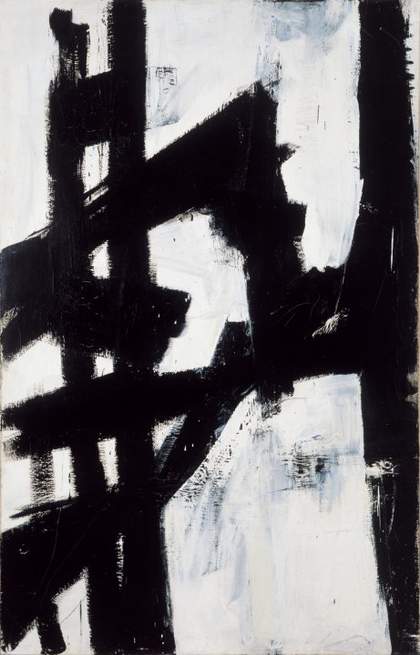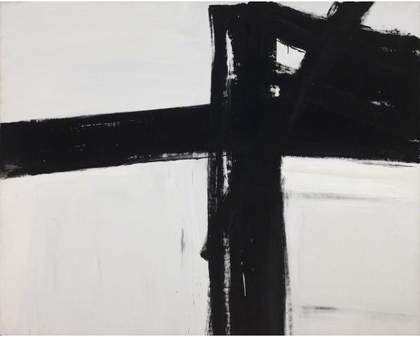Franz Kline’s background in printmaking determined not only his artistic development, including his move to abstraction in the late 1940s, but also his artistic self-conception. Kline’s heroes were not Pablo Picasso and Henri Matisse or José Clemente Orozco and David Alfaro Siqueiros, but instead mainly American artists who had found success and fame during the previous century in London – a success of the kind that no American artist had yet found in Paris. Kline aspired to be one of ‘our illustrator masters’, as he wrote to his friend Frederick Ryan in 1936: the next master following the nineteenth-century line of American expatriate artists in London.1 When Kline lauded one such artist, James Abbott McNeill Whistler, it was not for the painting for which he was best known, but rather for his role as an illustrator and printmaker, which testifies to the specificity of Kline’s artistic interests in 1936. This view of Whistler was not uncommon during the period that Kline was in London (1935–8), as Whistler was known for helping to lead the nineteenth-century revival of etching in France and England. Indeed, among connoisseurs, Whistler was often described during this period as a master etcher, placed on the same level of artistic achievement as Rembrandt and Charles Meryon – the figure to whom Kline paid homage in his Meryon 1960–1 (Tate T00926).2 This section examines how Kline developed an aptitude for the representation and abstraction of national cultural identity through both his self-fashioning as a lover of English culture and his references to American industry and cities. The essay ‘Merion, Meryon and Meryon’ then interprets Meryon in this context, as both a continuation of Kline’s effort to picture the forces at work in America at mid-century and a new attempt to deeply historicise and generalise these forces through a comparison with the work of Charles Meryon in mid-nineteenth-century Paris.
An ‘All-American’ Englishness
Kline’s Anglophilia was apparent before his move to England – it began, behaviourally, with his saving up money to buy a Burberry coat while a student in Boston in the early 1930s – but it became even more evident upon his return to the United States in 1938 and endured thereafter.3 Kline’s mother was English, as was his wife Elizabeth, whom he met at the Heatherley School of Fine Art in London in 1937. Had Kline seen through his application for citizenship, he would have become English too.4 During the 1950s in New York, Kline’s adoption of English dress and manners was an oddity upon which fellow artists, such as Willem de Kooning and Robert Rauschenberg, remarked. De Kooning said: ‘He was an Anglophile in a nice way’.5 Rauschenberg recalled:
And also his idea about somehow London was the answer to all the good ideas in taste. And Princess Margaret was his idea of when a girl was really beautiful, ‘like Princess Margaret’. I mean it was just a feeling he had; it was all an abstraction. I don’t think he wanted everybody to look English or anything but it was a style.6
After Kline’s death, Elaine de Kooning nevertheless typically stressed Kline’s ‘All-American’ effect, which is a leitmotif of the Kline literature.7 This quality, which was so essential, individually and collectively, to the mythology of the New York School of abstract expressionists, was relatively easy to demonstrate in Kline’s case in biographical terms. Kline was the son of immigrants – his father from Germany and his mother from England – but he hailed from Pennsylvania coal country, had been a star football player in high school and retained, into adulthood, the charisma, confidence, energy and strength one would expect from a former varsity team captain. This did not mean, however, that Kline was uncritical of American culture, especially in relation to art. At a symposium presented by the American Abstract Artists at New York’s Museum of Modern Art in 1954, Kline proclaimed, to applause from the audience: ‘Now coming from a country where you eat Shredded Wheat and you’re supposed to grow up and become successful it’s rather difficult to find out just where art is.’8 Kline continued: ‘The funny papers and museums can’t quite take care of it, you know. I mean abstract art is wonderful because it’s already taken care of it.’9 Not only did Kline recognise the elusiveness of art in a materialistic American culture, he also regarded abstract art in particular as a fortuitous, ready-made solution to this problem.
It may have been thanks to Kline’s Anglophilia and immersion within English culture, including its appreciation of illustration, that he developed so deep a knowledge of American culture. Immersion in a foreign country may have made his native culture seem new and strange. Elaine de Kooning’s analysis of Kline’s aptitude for the discovery and display of Americana is telling:
Franz Kline recognized the gestures of American style wherever he looked and he had an uncanny ability to project its particularities and breadth through paint. American style, as he saw it – with a fan’s zest and expertise – had an element of the comic: the big, brash, breezy gesture that, carried to its extreme, becomes a not-unconscious parody of itself, as in the design of the Cadillac or the cut of the zoot suit, as in the movie-queen’s inevitable role of female impersonator, as in the fanciful sentimentality of Tin Pan Alley songs, as in the movies based on the lives of stars, played by the stars themselves – Gloria Swanson in Sunset Boulevard [1950] – as in the jovial, mechanized rhythms, so instantly recognized abroad, of popular dances from the Charleston, the Black Bottom, the Tango, through the Bunny-Hug, the Lindy, the Big Apple, Truckin’, to the Twist, the Fly, and the Mashed Potatoes.10
Identification with American culture is not the same as having an ‘All-American’ identity, although the former can easily be mistaken for the latter. It is also different from what de Kooning describes, which is Kline’s aesthetic pleasure in national cultural difference.
Abstracting the national

Fig.1
Franz Kline
New York, N.Y. 1953
Oil on canvas
2007 x 1283 mm
Albright-Knox Art Gallery, New York
© ARS, NY and DACS, London 2017
The abstract expressionists, as well as American critics, took the task of developing a distinctly American art seriously. However, it is arguable that among the artists only Kline was explicit in this task, insofar as he gave his works titles that spoke, lovingly and longingly, of Americana, especially of the landscapes and cityscapes of his native Pennsylvania and his adopted city of New York. How did the mines, towns, trains and railroads of Pennsylvania relate to the metropolis? Or, to pose the same question through Kline’s works, as the artist arguably did: how can we explain the relationship between Kline’s New York, N.Y. 1953 and his Bethlehem 1959–60 (figs.1 and 2)? Except for Greenwich Village, much of New York, including Union Square where Kline lived after moving from the Village, was under construction during the 1940s and 1950s, with old stone buildings giving way to skyscrapers in the International Style. Most basically, and materially, it was the steel from Bethlehem, Pennsylvania, that provided the internal skeletons of these structures in New York. Kline was presenting the American industrial economy in his oeuvre.

Fig.2
Franz Kline
Bethlehem 1959–60
Oil on canvas
1581 x 1988 mm
Saint Louis Art Museum, Saint Louis
© ARS, NY and DACS, London 2017
From the 1950s onwards the black forms of Kline’s paintings were described by critics metaphorically as girders – a reading that could feasibly be applied to Meryon. This was likely a cumulative result of his titles, which invoked coal country and the city, and his shift in forms away from the figurative – even the mechanical ‘figure’ of the locomotive – and towards the structures of architecture and engineering that carried these trains across the United States. The blackness of the forms, their matte finish, with an occasional edge of impasto, their relative thickness and length, as well as the way they were arranged in patterns suggested the possibility of structural support, a load-bearing capacity. Whether or not Kline depicted New York in New York, as the title promises, or recognised the city in his painting after finishing it, he nonetheless illustrated the common sight of construction with cranes in motion – a neck-craning vision that could never be seen in total from the street, because the buildings reached from the ground into the clouds. If construction is represented in New York then it is not the work of a machine but of man, despite his smallness. There are no clean lines and no right angles in these structures, no certitude that what is being built will stand. If Kline depicts Bethlehem in Bethlehem, the cruciform shape is similarly easy to describe metaphorically as a bridge, over which the steel produced by Bethlehem Steel, the famous corporation named after the town, is transported. That the title and form also recalls Jesus’s birthplace and fate does not diminish the painting’s American meaning. It only enhances it, given the importance of the steel industry to the American economy over the previous century and, from Kline’s perspective as a native of the Pennsylvania coal-mining town of Wilkes-Barre, its rapidly diminishing vitality by mid-century.11
The Americana that Kline pictures is national in scope, because of the way in which the urban and the industrial, the metropolitan and the regional are linked. This is the full measure and power of Kline’s abstraction. His black forms have the ability to represent what is invoked in his paintings’ titles, but also to operate together and thus suggest a much more expansive and abstract notion of American industrial power as it was known and admired throughout the world. This was a power that demanded extra-large canvases, utilitarian, industrial paints and bold gestures in high contrast. What makes Kline’s painting American is his ability to extract from the urban and the regional a meaning that is national: America at mid-century was a seemingly endless supply of natural resources, ambition and self-evident achievements in the form of skyscrapers and bridges.
